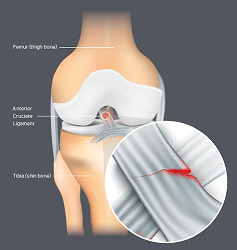
Ligaments are elastic bands of tissue that attach bones together. In the knee, four ligaments connect the thighbone (femur) to the shin bone (tibia), allowing the knee joint to move and rotate with strength and stability. The anterior cruciate ligament (ACL), located in the center of the knee, controls forward movement and rotation, and helps prevent the knee from hyperextending.
ACL injuries happen when too much force is placed on the ligament and the tissue is stretched or torn. ACL sprains and tears most often result from sudden stops, abrupt changes in direction, or jumping and landing — all common movements in sports such as soccer, football and basketball. Less often, ACL injuries happen when players collide.
An injured ACL causes the knee to “give out” and become unstable. The knee becomes swollen, painful and weak; depending on the severity of the injury, it may be unable to bear weight.
Symptoms of an ACL Injury
Pop
Many people report hearing a loud “pop” or a “popping” sensation in the knee when the ACL is injured.
Pain
A sprained or ruptured ACL causes severe, immediate pain. You will not be able to continue activity and may not be able to put weight on the knee at all.
Rapid swelling
Your knee will quickly become swollen and may feel warm and tender to the touch.
Instability
A tear or sprain of the ACL will cause the knee to “buckle” or give out. The joint will feel unstable and will be unable to bear weight.
If you have signs or symptoms of an ACL injury, seek medical care right away. In addition to doing a physical exam of your knee, joint function and range of motion, your doctor may order tests to assess the severity of the injury, including x-rays, an ultrasound exam or an MRI.
Managing ACL Injury
Your options for managing your ACL injury depend on several factors, including how severe the injury is and your lifestyle. Minor sprains may just need rest and home care, while ruptures almost always require surgery to repair.
Here are some of the most common treatments:

RICE: Rest, ice, compression and elevation may be enough for minor ACL injuries. Applying ice, wrapping the knee with an elastic wrap and keeping it elevated all help reduce swelling. Ice can help reduce both swelling and pain.
Medications: Anti-inflammatory medications available over the counter or by prescription can help relieve swelling and pain. Your doctor may recommend a cortisone injection to ease severe inflammation, but cortisone will not restore stability to the knee.
Bracing: A knee brace can help provide support to an injured ACL while it heals. Moderate-support braces may be enough for everyday activities, while runners and athletes may need greater support for their sports. DJO offers a complete line of braces to protect, support and rehabilitate the knee joint and ligaments. Talk to your orthopaedic specialist about finding the best brace for your needs.
Physical Therapy: As your ACL heals, physical therapy can help strengthen the muscles around your knee joint and restore mobility and range of motion.
Surgery: Surgery may be required if your ACL has ruptured or is severely injured, especially if you are an athlete. The surgeon will remove the damaged ACL and reconstruct it with tissue to help promote new ligament growth. Recovery may include a series of braces along with physical therapy.
Why brace after ACL reconstruction?
Your clinician may prescribe a functional knee brace after you have regained full range of motion—that’s usually between three to five months after surgery. Graft strength of the new ACL is considerably weaker than the native (original) ACL during the first 12 months, so a brace during this early period helps protect it from harmful forces that occur in everyday life or in sport. The right brace can help protect both your injured knee and your healthy knee from future injury.

